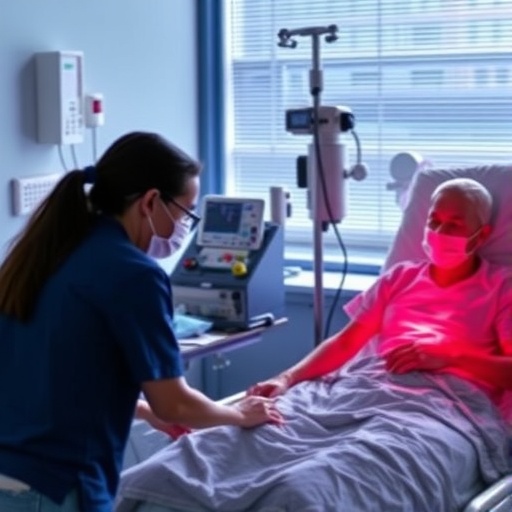
Credit: Case Western Reserve University School of Medicine
The odds of a black or Hispanic patient visiting an outpatient dermatologist are about half that of a white patient with the same skin condition, according to a new study in JAMA Dermatology. Patients most likely to receive outpatient dermatologic services in the study were white, educated women. The findings are among several that describe disparities in the use of outpatient dermatology services.
The new study includes nine years of data from 183,054 dermatology patients across the country. Researchers from Case Western Reserve University School of Medicine and University Hospitals Cleveland Medical Center analyzed the data looking for demographic and socioeconomic patterns associated with use of dermatologic services.
"Patients who were male, uninsured, Midwestern, insured by Medicaid/Medicare, or had a lower income or educational status were least likely to receive outpatient dermatologic care," said the study's first author, Raghav Tripathi, MPH, medical student at Case Western Reserve University School of Medicine. The odds of a man seeking treatment for a dermatologic condition were about two-thirds that of a woman. Across all patients, service utilization increased proportionately with education level and income.
More services for certain patients meant higher costs: the per capita expenditure for white patients ($210) was approximately three times that of black ($63) or Hispanic ($73) patients. While other variables might have had an impact, ethnic disparities still persisted after the researchers controlled for education level, income, insurance status and sex. "We were surprised by the magnitude of these differences," Tripathi said.
As demographics throughout the country become more diverse, understanding disparities in how patients use health services will be integral to developing policies that increase access to care. According to the authors, recent policies under the Patient Protection and Affordable Care Act increased access to care for low-income and low-education individuals, but did not significantly improve disparities for specific ethnic groups. It also did not increase access to specialized care, like dermatology, for many demographics.
Said Tripathi, "We hope our findings will encourage hospitals and dermatology clinics to consider their own quality improvement measures, designed to increase access to care among their patients. These could include interventions for minority-specific care, such as having an onsite translator, including a financial counselor in the appointment, or increasing outreach in rural areas."
Case Western Reserve researchers identify who is getting care and who isn't
Patients may also benefit from interventions that target specific dermatologic conditions. Half of the patients in the new study had a diagnosed dermatologic condition, yet only 36 percent of diagnosed patients sought care. Most patients diagnosed with a skin condition did not seek care at all during the nine-year study period.
The least likely to seek care were patients diagnosed with chronic skin ulcers. Nine out of ten patients with chronic skin ulcers did not see a dermatologist during the study period. Chronic ulcers are a common complication of diabetes and vascular disease. Dermatologists can help recognize such ulcers and get patients into proper treatment. Without seeking care, patients may be unaware of the root causes of their skin conditions.
Patients most likely to seek care in the new study were those diagnosed with non-melanoma skin cancers. Three out of four of these patients had at least one outpatient dermatologist visit during the study period. High service utilization in this population could prevent their non-melanoma lesions from turning more serious.
Previous research has shown the importance of visiting a dermatologist for patients with skin conditions. Early and accurate diagnoses can improve outcomes, and stave off deadly cancers. Patients least likely to seek care, whether due to demographics or diagnosis, could be at higher risk for serious skin conditions.
"Differences in utilization of outpatient dermatologists may be a key predictor for increased mortality and detriment to quality of life in different groups," Tripathi said. "By understanding the reasons behind these differences through studies like ours, we can begin to develop population-based, targeted interventions."
###
Tripathi, et al. "Association of demographic and socioeconomic characteristics with differences in use of outpatient dermatology services in the United States." JAMA Dermatology. 2018. doi:10.1001/jamadermatol.2018.3114
Audio Interview: Differences in Use of Outpatient Dermatology Services in the United States
Tripathi, fellow medical student Konrad D. Knusel, and the study's senior author, Jeremy S. Bordeaux, MD, MPH, professor of dermatology at Case Western Reserve University School of Medicine and member of the Case Comprehensive Cancer Center, presented a portion of this work earlier this year at the International Investigative Dermatology Conference in Orlando, Florida.
For more information about Case Western Reserve University School of Medicine, please visit: case.edu/medicine.
Media Contact
Ansley Gogol
[email protected]
216-368-4452
@cwru
http://www.case.edu
Original Source
http://casemed.case.edu/cwrumed360/news-releases/release.cfm?news_id=1465&news_category=8 http://dx.doi.org/10.1001/jamadermatol.2018.3114





